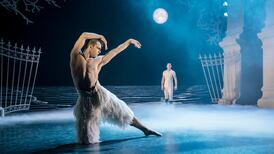As the Dublin Dance Festival continues, the intentional interweaving of recurring motifs and styles by festival director Benjamin Perchet became more apparent. This week, three shows drew our attention again to notions of time, perception and the search for identity and human contact.
Sunny ★★★★★
The Abbey Theatre
With a blast of appropriately intense white sunlight, the week began with Sunny, a meditation on time passing and the myriad possibilities of human interaction. In contrast to last week's wonderfully hypnotic Greek Elvedon, this show shifted gear and deftly focused on a freeform day teeming with exuberant live music and movement, with energy and optimism.
Israeli/French choreographer and designer Emmanuel Gat’s 10 athletic dancers loped, huddled and casually collided as sunlight filled the empty stage of the Abbey Theatre. Awir Leon, Gat’s musical collaborator and performer was also limbering up at his keyboard and mixing desk, tweaking his sounds for the day ahead.
Then those rhythms of Sunny made famous by Marvin Gaye began and a tone was set. With the sun rising higher, the dancers began to pick up pace and responded to the light and the music, their bare limbs stretching and extending to the sky. The energy and mood soared and dipped by turn in movement, sound and sunlight. When the music reached a crescendo, the dance accelerated; arms, legs and elbows angling, figures leapfrogging or rolling into phases of vibrant hip-hop and breakdancing moves.
Time out was a carnivaleque interlude of dancers masking up and playacting with each other before they became restless again returning to creating vibrant elemental dance. Gat’s imagined designer sun eventually grew red in the sky as night approached and his dancers bodies created final great swathes and splashes of athletic colourful moves. Uplifting and finely tuned in every sense.
Merry.go.round ★★★★
Samuel Beckett Theatre
A more sombre note infused the interactions and playacting of Maria Nilsson Waller's merry.go.round. This Swedish dancemaker's work also opened with a shaft of sunlight. But here we engaged with the collision of strangers in restricted interior spaces, seeking love or resolution.
The dance style was theatrical, even operatic, and evoked fragments of historical or mythical lives; sometimes these were intimated by defined movement as in Justine Cooper’s regal and unhappy Queen or in murmured shards of stories among the dancers about a scandalous and infamous passion of a professor and his student.
Cleaving bodies in embracing duets spoke to occasional success in love. But these were short-lived as dancers soon parted and the disjointed merry go round began again. At times, the work seemed a little cluttered with unclear references, as when dancers created tableaux, but some striking images persisted. These included dancer Marcia Liu’s leg arcing achingly over the back of an abandoned chair, pure emotion among the debris of disappointment.
Singspiele ★★★★★
Project Arts Centre Upstairs
Sublime storytelling and exquisite composition reigned in French choreographer Maguy Marin's Singspiele for her collaborator, the actor and performer David Mambouch. Together they invited us into an unsettling world of ever-changing identities and invisible lives.
Against a white-lit screen, Mambouch moved slowly along a ledge from left to right, undressing and redressing himself from the laden clothes hooks above his head, while unpeeling from his own face a succession of black and white photos of diverse facial images which gave each newly dressed figure a distinctive if transient persona.
In this re-imagined identity parade, we were invited to look at them fleetingly, maybe even recognise them; the famous, infamous and unknown, the old and young, the women and men. The addition of a waistcoat, the loosening of a tie, the unbuttoning of a shirt changed our perceptions.
Mabouch’s intuitive gestures added a quick swagger, a crumpled shoulder, or a hand clutching a handbag while Alex Beneteaud’s cinematic lighting picked up dead eyes, a forced smile, or too painted lips. The images became real people in a world, finely evoked in Mambouch’s own sound design: an urban space with noisy boulevards and bleating cars, streets where human chatter dominated or lonely late-night streets with the sound of cruising cars.
Singspiele was an eloquent, unsettling and haunting work, beautifully conceived and skilfully performed.
















